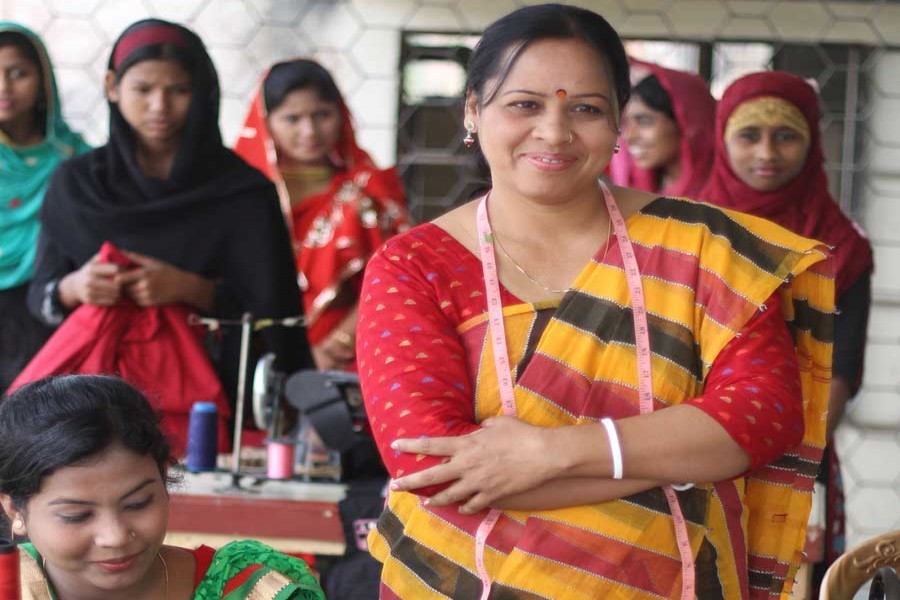
Published :
Updated :

In rural economy, the activities that generate income for the household or save household expenditures are economic activities. These include employment in agricultural and non-agricultural labour market and also unpaid work for household in crop production activities, homestead gardening, livestock and poultry rearing, fishing, cottage industry (handicraft production), house repairing and construction work, transport operation, business, trade and shop keeping, and personal services.
There are many other activities done by women which are quasi-economic in nature. These include food processing and preparation of meals for family members, child care, care of old and sick family members, and tutoring of children. If the household had hired people for doing these jobs, it would have involved some expenditure. However, these are not included as economic activities in national income accounting practice of Bangladesh.
Women these days are heavily involved in poultry raising, animal husbandry, home gardening and crop cultivation such as post-harvest operations, drying and seed selection. Since these are mostly homestead-based activities, they find it convenient to carry these out in between conducting domestic duties.
Activities in which rural women are involved relatively full-time, are non-farm ones. In contrast, major economic activities for men are crop farming, non-farm services, business, and shop keeping, and transport operation.
The importance of cultivation in generation of employment is on a downward trend. This is because of continuous reduction in farm size under population pressure. In recent years, though, farming is attracting more labour due to increased farm profitability from upward trend in agricultural prices.
On the other hand, the opportunity of job creation in the rural non-farm sector is on the rise. This is due to expansion of rural roads and generation of marketed surplus from agriculture (transport and trade services), expansion of supply of micro-credit (generating self- employment in trade and business) and expansion of education and health services in rural areas. Labour has also moved out of cottage industries with the expansion of rural roads and electrification.
Over the last two decades women's involvement in crop cultivation has sharply declined. This is mainly because of the fact that involvement of women in post-harvest operations, particularly for rice processing (i.e. winnowing, drying, parboiling, husking /milling, etc.) have been mechanised.
At present, rural women are involved mostly in livestock and poultry production activities rather than crop production activities. Participation of adult women in livestock and poultry production activities increased from 43 per cent in the 1980s to 69 per cent in recent years. Involvement of women in homestead gardening has also increased in recent years. Credit support from non-governmental organisations (NGOs) has largely facilitated involvement of women in livestock and poultry rearing as well as in homestead gardening in rural Bangladesh. Participation of women in fisheries activities is found to be negligible.
Very few women participate in the agricultural labour market. In the 1980s, only 2.0-3.0 per cent of women workers sold labour in the agricultural labour market compared to 25 per cent among male workers. Women's participation in the agricultural labour market has further declined in recent years. Actually, participation of women in the agricultural labour market is poverty-induced. Since poverty has improved substantially over the last two decades women's participation in the agricultural labour market has also declined.
In order to understand the drivers of women's participation in agricultural activities, a logit regression model (qualitative dependent variable) was conducted. The dependent variable was measured by a dummy variable with value "one" for households where women allocated more than one hour a day for agricultural activities and zero otherwise. The explanatory variables included the wage rate for agricultural labour and for non-agricultural labour at the village level, land owned by the household (ha), cultivated land with access to irrigation (ha), number of years of schooling of the women worker, whether the worker is a member of a microfinance organisation, the age of the worker and the age square (to capture the non-linear effect of age), the distance of the village from the nearest bus stop, and whether the village has access to electricity.
The results of regression analyses carried out in various studies indicate that agricultural wage rate has a positive effect on participation in agriculture, while the non-agricultural wage rate has a negative effect. Women's participation might increase if tightening of labour market increased agricultural wage rate. Developed infrastructure facilities (electricity connection and closer to transport facilities) will induce women to participate more in agriculture. Higher education has negative effect on participation. Similarly access to credit through NGOs contributes to greater participation in agricultural activities. The size of land ownership has a neutral effect, but irrigated land increases participation through increase in agricultural production that requires women to engage in post-harvest operation. Older women participate more in agricultural activities than younger women, but the positive effect gets slowed down as women become older. A major policy implication of the findings is that supply of credit will encourage more women to engage in agriculture. Also investment for infrastructure development may promote participation in agriculture by facilitating linkage with markets.
Following the exodus of male labour force from agriculture to non-agriculture lured by higher wages, coming days could see women shouldering the yoke of agriculture.
Abdul Bayes is a former Professor of Economics at Jahangirnagar University.
[email protected]/abdul.


 For all latest news, follow The Financial Express Google News channel.
For all latest news, follow The Financial Express Google News channel.